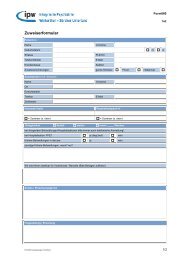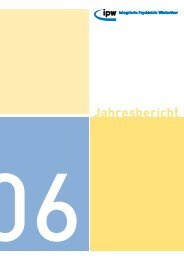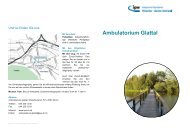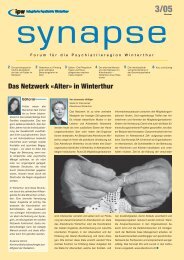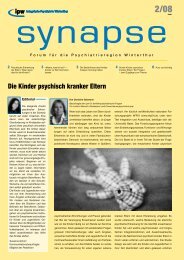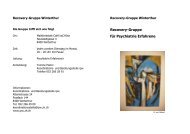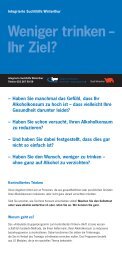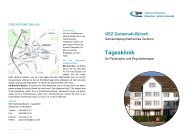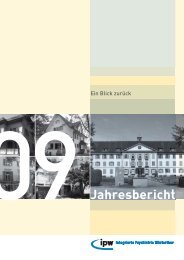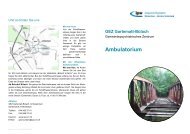Dr. med. Carlo Caflisch
Dr. med. Carlo Caflisch
Dr. med. Carlo Caflisch
Create successful ePaper yourself
Turn your PDF publications into a flip-book with our unique Google optimized e-Paper software.
Zentrum für Abhängigkeitserkrankungen<br />
Selnaustrasse 9, 8001 Zürich<br />
•S•S•A•M•<br />
Swiss Society of Addiction Medicine<br />
Schweizerische Gesellschaft für Sucht<strong>med</strong>izin<br />
Société Suisse de Médecine de l'Addiction<br />
Società Svizzera di Medicina delle Dipendenze<br />
Hochdosisabhängigkeit von<br />
Benzodiazepinen<br />
<strong>Carlo</strong> <strong>Caflisch</strong><br />
Zürich, September 2007
ZENTRUM FÜR ABHÄNGIGKEITSERKRANKUNGEN<br />
DER PSYCHIATRISCHEN UNIVERSITÄTSKLINIK ZÜRICH<br />
Selnaustrasse 9, 8001 Zürich<br />
Telefon: 044 205 58 00 Fax: 044 205 58 02<br />
Ambulanter Bereich<br />
Abklärung und Behandlung von Patienten mit Störungen durch<br />
psychotrope Substanzen<br />
Spezialsprechstunden für: Alkohol / Störungen durch Kokain /<br />
Cannabis und „moderne“ <strong>Dr</strong>ogen<br />
Tagesklinik<br />
zur <strong>med</strong>izinischen, sozialen und beruflichen Reintegration<br />
<strong>Dr</strong>ogen-Notfalldienst<br />
Erreichbar über das Ärztefon 044 321 21 21 (01 269 69 69)<br />
Mo-Fr: 18.30-08.00 Sa/So: 24h<br />
Forschungsgruppe
Morphin 1804<br />
Kokain 1860<br />
Geschichte der Psychopharmaka<br />
Barbital 1902 VERONAL<br />
Chlorpromazin 1953 LARGACTIL<br />
Imipramin 1957 TOFRANIL<br />
Chlordiazepoxid 1960 LIBRIUM
1953-1965<br />
Die Lancierung der Benzodiazepine<br />
1957 Entdeckung der Benzodiazepin-Gruppe<br />
Mitte der fünfziger Jahre wird eine neue Gruppe von<br />
Beruhigungsmitteln (Tranquilizer) in die Therapie eingeführt.<br />
Leo Sternbach greift auf eine Substanzklasse zurück, die er<br />
bereits früher bearbeitet hat, und stösst dabei auf die Gruppe<br />
der Benzodiazepine. Eines davon, Ro-5-0690, wird später unter<br />
dem Namen Librium eingeführt werden.
Librium wird als erstes Medikament der neuen Substanzklasse<br />
der Benzodiazepine zur Behandlung emotioneller,<br />
psychosomatischer und muskulärer Störungen eingeführt.<br />
Librium erlebt einen spektakulären Markterfolg und eröffnet ein<br />
weites internationales Forschungsfeld bei Roche.<br />
Modifikationen an der Basisstruktur der Benzodiazepine führen<br />
zu einer Reihe von Produkten: Librax (1961), Valium Roche<br />
(1963) Mogadon (1965), Limbitrol (1967), Nobrium (1968),<br />
Dalmadorm (1972), Rivotril (1973), Lexotanil (1974), Rohypnol<br />
(1975) und Dormicum (1982).
Leavitt et al. 2000<br />
When „Enough“ Is Not Enough: New Perspectives on<br />
Optimal Benzodiazepine (BZD) Maintenance Dose<br />
Gewisse Programme verschreiben ungenügende tägliche BZD<br />
Dosen. Die Patienten klagen über Entzugssymptome und sie<br />
hören nicht auf, illegal erworbene BZD dazu zu konsumieren.<br />
Trotzdem sind Praktiker kaum gewillt die BZD-Tagesdosen<br />
über eine gewisse mehr oder weniger willkürliche Grenze zu<br />
erhöhen.<br />
Serumspiegel helfen kaum weiter.<br />
Indikatoren für eine ungenügende Substitution sind:<br />
Entzugssymptome und fortgesetzter Konsum von zusätzlichen<br />
nicht verordneten BZD.
Leavitt et al. 2000<br />
When „Enough“ Is Not Enough: New Perspectives on<br />
Optimal Methadone Maintenance Dose<br />
The Mount Sinai Journal of Medicine Vol. 67<br />
Some methadone maintenance treatment (MMT) programs<br />
prescribe inadequate daily methadon doses. Patient complain of<br />
withdrawal symptoms and continue illicit opioid use, yet<br />
practitioners are reluctant to increase doses above certain<br />
arbitrary thresholds.<br />
New research suggests that doses ranging from 120mg/d to<br />
more than 700mg/d, with correspondingly higher serum<br />
methadone levels, may be optimal for many patients.
April<br />
Di 03. 40 Tbl. Seresta forte à 50mg<br />
Mi 04. 80 Tbl. Seresta forte à 50mg<br />
Sa 07. 80 Tbl. Seresta forte à 50mg<br />
60 Tbl. Dormicum à 15mg<br />
60 Tbl. Rohypnol à 1mg<br />
Fr 13. 80 Tbl. Seresta forte à 50mg<br />
60 Tbl. Dormicum à 15mg<br />
60 Tbl. Rohypnol à 1mg<br />
Herr R. M. , *1968<br />
when „enough“ is not enough<br />
April<br />
Mi 18. 40 Tbl. Seresta forte à 50mg<br />
Fr 20. 80 Tbl. Seresta forte à 50mg<br />
60 Tbl. Dormicum à 15mg<br />
60 Tbl. Rohypnol à 1mg<br />
Fr 27. 80 Tbl. Seresta forte à 50mg<br />
60 Tbl. Dormicum à 15mg<br />
60 Tbl. Rohypnol à 1mg<br />
Entspricht fast 500mg Diazepam tgl.
The purpose of the study was to assess prevalence of benzodiazepine use in the<br />
Swiss adult population and to assess on benzodiazepine prescription patterns of<br />
physicians in domiciliary practice.<br />
Study design A retrospective, population-based cross-sectional study with<br />
520 000 patients covering a 6-month period.<br />
Methods We estimated the prevalence, amount and duration of benzodiazepine<br />
use using a pharmacy dispensing database.
Results Of all patients, 9.1% (n= 45 309) received at least one benzodiazepine<br />
prescription in the 6-month period. Most persons receiving benzodiazepine<br />
prescriptions were women (67%), and half of all patients were aged 65 or older. Of<br />
45 309 patients with benzodiazepine prescriptions, 44% (n =19 954) had one single<br />
prescription, mostly for a short period ( 90 days), and in lower than the<br />
recommended or within the recommended dose range.<br />
In patients with long-term use (n= 25 354), however, 1.6% (406) had benzodiazepine<br />
prescriptions in extremely high doses. The sample of patients with repeated<br />
prescriptions allowed an estimation of a benzodiazepine use of 43.3 daily defined<br />
doses per 1000 inhabitants in Switzerland.<br />
Conclusions Benzodiazepine prescriptions were appropriate for most patients and<br />
thus were prescribed in therapeutic doses, as indicated in the treatment guidelines.<br />
On the other hand, our survey showed that 1.6% of the patients had prescriptions for<br />
long time periods at very high doses, indicating an abuse or dependence on<br />
benzodiazepines in this subgroup.<br />
Int Clin Psychopharmacol 22:292–298 c 2007 Lippincott Williams & Wilkins.
<strong>Dr</strong>ug Alcohol Depend. 1993 May;32(3):257-66.<br />
Benzodiazepine and sedative use/abuse by methadone maintenance<br />
clients.<br />
Iguchi MY, Handelsman L, Bickel WK, Griffiths RR.<br />
Hahnemann University School of Medicine, Department of Mental Health<br />
Sciences, Philadelphia, PA 19102-1192.<br />
Clients at three geographically separate methadone maintenance clinics were<br />
surveyed regarding their lifetime use of ten commonly used benzodiazepines<br />
and barbiturates. In Baltimore (n = 50), 94% reported use of one or more of<br />
these drugs in their lifetime, with 66% reporting use in the last 6 months. In<br />
Philadelphia (n = 218), 78% reported use in their lifetime, with 53%<br />
reporting use in the last 6 months. In New York City (The Bronx) (n = 279),<br />
86% reported use in their lifetime, with 44% reporting use in the last 6<br />
months. Subjects reporting a history of use of at least 7 of 10 of the na<strong>med</strong><br />
sedatives were recruited for a more detailed interview. They reported that,<br />
among the benzodiazepines, diazepam, lorazepam, and alprazolam were<br />
frequently used for their 'high' producing effects, and for selling to produce<br />
income. In contrast, chlordiazepoxide, oxazepam, and phenobarbital, had<br />
much lower ratings of 'high' and were much less likely to be obtained for<br />
getting 'high' or for resale.
AWMF online<br />
Arbeitsgemeinschaft der<br />
Wissenschaftlichen<br />
Medizinischen<br />
Fachgesellschaften<br />
Leitlinien der Dt. Ges. f. Suchtforschung und Suchttherapie (DG-Sucht)<br />
und der Dt. Ges. f. Psychiatrie, Psychotherapie und Nervenheilkunde (DGPPN)<br />
AWMF-Leitlinien-Register<br />
Nr. 076/009<br />
Entwicklungsstufe:<br />
Medikamentenabhängigkeit<br />
(Sedativa-Hypnotika, Analgetika, Psychostimulantien)<br />
2
Eine Abhängigkeit von Benzodiazepinen (BZD) in<br />
therapeutischer Dosierung wird bei Langzeitanwendung<br />
ohne Behandlungsunterbrechung häufig nicht manifest<br />
und nicht als problematisch erlebt.<br />
Bei Vorliegen eines Entzugswunsches sollte<br />
ausschleichend über 4-10 Wochen herabdosiert werden,<br />
schlagartiges Absetzen ist zu vermeiden.<br />
Kurzwirksame BZD und die "3 Z" sollten auf eine<br />
Äquivalenzdosis eines Standard-BZD (z.B. Diazepam,<br />
Dikaliumchlorazepat) umgestellt werden.
Bei langwirksamen BZD kann mit der Substanz selbst<br />
oder einer Standardsubstanz entzogen werden.<br />
Eine psychologische Unterstützung der<br />
Entzugsbehandlung ist durchzuführen, auch kann die<br />
Verwendung anderer Psychopharmaka notwendig<br />
werden.<br />
Bei Misslingen des ambulanten Entzuges, bei<br />
Hochdosisabhängigkeit von BZD oder bei<br />
Abhängigkeit von Clomethiazol ist ein stationärer<br />
Entzug angeraten.
Index · Contents · Introduction · Chapter I · Chapter II · Withdrawal Schedules · Chapter III<br />
Medical Disclaimer · Order A Printed Copy · Professor Ashton's Main Page<br />
The Ashton Manual in other languages<br />
ASHTON MANUAL INDEX PAGE<br />
BENZODIAZEPINES: HOW THEY WORK<br />
AND HOW TO WITHDRAW<br />
(aka The Ashton Manual)<br />
• PROTOCOL FOR THE TREATMENT OF BENZODIAZEPINE WITHDRAWAL<br />
• Medical research information from a benzodiazepine withdrawal clinic<br />
Professor C Heather Ashton DM, FRCP<br />
Revised August 2002<br />
• Ashton Manual Index Page<br />
• Contents Page<br />
• Introduction<br />
• Chapter I: The benzodiazepines: what they do in the body<br />
• Chapter II: How to withdraw from benzodiazepines after long-term use<br />
• Chapter II: Slow withdrawal schedules<br />
• Chapter III: Benzodiazepine withdrawal symptoms, acute & protracted
Schedule 10. Withdrawal from oxazepam (Serax) 20mg three times daily (60mg) with diazepam<br />
(Valium) substitution (20mg oxazepam is approximately equivalent to 10mg diazepam)<br />
Starting dosage<br />
Stage 1<br />
(1 week)<br />
Stage 2<br />
(1 week)<br />
Stage 3<br />
(1 week)<br />
Stage 4<br />
(1-2 weeks)<br />
Stage 5<br />
(1-2 weeks)<br />
Stage 6<br />
(1-2 weeks)<br />
Stage 7<br />
(1-2 weeks)<br />
Stage 8<br />
(1-2 weeks)<br />
Stage 9<br />
(1-2 weeks)<br />
Morning<br />
oxazepam 20mg<br />
oxazepam 20mg<br />
oxazepam 10mg<br />
diazepam 5mg<br />
oxazepam 10mg<br />
diazepam 5mg<br />
oxazepam 10mg<br />
diazepam 5mg<br />
Stop oxazepam<br />
diazepam 8mg<br />
diazepam 8mg<br />
diazepam 10mg<br />
diazepam 10mg<br />
diazepam 8mg<br />
Midday<br />
oxazepam 20mg<br />
oxazepam 20mg<br />
oxazepam 20mg<br />
oxazepam 10mg<br />
diazepam 5mg<br />
oxazepam 10mg<br />
diazepam 5mg<br />
oxazepam 10mg<br />
diazepam 5mg<br />
Stop oxazepam<br />
diazepam 8mg<br />
diazepam 2mg<br />
Stop diazepam<br />
--<br />
oxazepam 10mg<br />
diazepam 5mg<br />
oxazepam 10mg<br />
diazepam 5mg<br />
Stop oxazepam<br />
diazepam 8mg<br />
diazepam 8mg<br />
diazepam 8mg<br />
diazepam 10mg<br />
diazepam 10mg<br />
diazepam 10mg<br />
Continue as on Schedule 2 from Stage 12<br />
Evening/Night<br />
oxazepam 20mg<br />
oxazepam 10mg<br />
diazepam 5mg<br />
Schedule 10 Notes:<br />
1.Oxazepam is short-acting (half-life 4-15 hrs) so substitution to diazepam (long-acting) is recommended.<br />
2.Diazepam need only be taken twice a day.<br />
3.A change from 5mg to 2mg diazepam tablets is necessary from Stage 4 onwards.<br />
Daily Diazepam<br />
Equivalent<br />
30mg<br />
30mg<br />
30mg<br />
30mg<br />
28mg<br />
26mg<br />
24mg<br />
22mg<br />
20mg<br />
18mg
Authors’ conclusions<br />
All included studies showed that gradual taper was preferable to<br />
abrupt discontinuation. The results of this systematic review<br />
point to the potential value of carbamazepine as an effective<br />
intervention for benzodiazepine gradual taper discontinuation.<br />
But, larger controlled studies are needed to confirm<br />
carbamazepine’s potential benefit, to assess adverse effects and<br />
to identify when its clinical use might be most indicated. Other<br />
treatment approaches to benzodiazepine discontinuation<br />
management should be explored (antidepressants,<br />
benzodiazepine receptors modulator).
Abstract<br />
Background: Opioid maintained patients report high levels of anxiety, but the use of<br />
benzodiazepines among these patients has been associated with negative outcomes<br />
such as increased risk of overdose and death and poorer retention in programmes.<br />
Previous research has used interview or urine analysis to assess benzodiazepine use.<br />
In this study a prescription database was applied.<br />
Methods: The Norwegian Prescription Database covers all prescriptions for the entire<br />
population from 1 January 2004. Benzodiazepine prescriptions to patients receiving<br />
methadone (N= 1364) or buprenorphine (N= 805) in 2004 and 2005 were studied.<br />
Type and amount of drugs received were investigated.<br />
Results: Overall 40% of the patients received at least one prescription for a<br />
benzodiazepine drug. Oxazepam was the most frequently prescribed drug. Female<br />
patients, methadone-maintained patients and patients in the liberal programmes<br />
received a prescription more often. Prescribed doses were high and highest in the<br />
liberal programmes. Older patients received more hypnotics. Dose of maintenance<br />
drug was positively related to amount of anxiolytics prescribed.<br />
Conclusions: This study showed that more benzodiazepines were prescribed to opioid<br />
maintenance treatment patients than previously shown by investigations using<br />
interview or urine analysis. The doses prescribed were generally high. In light of the<br />
negative outcomes following benzodiazepine use in these patients, Norwegian<br />
doctors need to review their prescription practices.
Australian and New Zealand Journal of Psychiatry 2003; 37:458–463<br />
Treatment of benzodiazepine dependence in<br />
methadone maintenance treatment patients:<br />
a comparison of two therapeutic modalities<br />
and the role of psychiatric comorbidity<br />
Tal Weizman, Marc Gelkopf, Yuval Mela<strong>med</strong>, Miriam Adelson, Avraham Bleich
EINLEITUNG<br />
Benzodiazepinabhängigkeit bei Patienten, die mit<br />
Methadon substituiert werden, ist weltweit endemisch.<br />
Gute Leitlinien, wie mit diesem Problem umgegangen<br />
werden soll, existieren nicht.<br />
Ziel dieser naturalistischen Studie von Weizman et al.<br />
war es, eine BZD-Entzugsbehandlung mit einer BZD-<br />
Substitutionsbehandlung zu verglichen.
METHODE (1)<br />
Benzodiazepinabhängige Patienten in einem<br />
Methadonprogramm in Tel Aviv.<br />
Ausreichende Methadondosen (keine gesetzlichen<br />
oberen Limiten).<br />
Interdisziplinäres Behandlungsteam.<br />
Tägliche Abgabe der Benzodiazepine.
METHODE (2)<br />
Von insgesamt 80 Patienten, bei denen eine langjährige<br />
Abhängigkeit auf hohe Dosen von BZD diagnostiziert worden<br />
war und die schon mehrmals versucht hatten abstinent zu<br />
werden, konnten im Verlauf von 3 Jahren 66 Patienten für die<br />
Studie rekrutiert werden.<br />
Alle erhielten die ersten 2 Wochen 6 mg Clonazepam pro Tag.<br />
Bei der Entzugsgruppe (n=33) wurde das Clonazepam über ca.<br />
6 Wochen ausgeschlichen.<br />
Bei der Gruppe der Substituierten (n=33) wurde versucht eine<br />
Erhaltungsdosis mit möglichst wenig Craving und Sedation<br />
einzustellen.
RESULTATE (1)<br />
Alle Patienten bis auf einer (65/66) missbrauchten<br />
hauptsächlich Flunitrazepam, zusätzlich wurde Diazepam<br />
(42/66), Alprazolam (9/66) und Nitrazepam (7/66) konsumiert.<br />
Die mittlere Erhaltungsdosis in der Gruppe der Substituierten<br />
war 2,64 mg Clonazepam (SD=1,46 mg, range 0.5-6 mg).<br />
Erhaltungsdosis 1-2 mg, n=16<br />
Erhaltungsdosis 3-4 mg, n=15<br />
Erhaltungsdosis 5-6 mg, n=2
RESULTATE (2)<br />
Nach 12 Monaten Erfolg Misserfolg<br />
Entzug mit Clonazepam 4 25<br />
Substitution mit Clonazepm 17 9<br />
p < 0.001
DISKUSSION (1)<br />
Die Substitution mit Clonazepam ist eine gute<br />
Therapieoption für BZD-abhängige Methadonpatienten<br />
mit einer langen Anamnese von BZD-<br />
Abusus und misslungenen Entzugsversuchen.<br />
Für die Subgruppe von Behandlungsversagern, die vor<br />
Behandlungsbeginn besonders hohe BZD-Tagesdosen<br />
konsumierten, war die Clonazepamdosis<br />
möglicherweise zu tief.
DISKUSSION (2)<br />
Patienten mit einer Achse-I-Störung profitierten mehr<br />
von der Behandlung mit Clonazepam als Patienten mit<br />
einer dissozialen Persönlichkeitsstörung.<br />
Limiten der Studie: Die Resultate basieren auf den<br />
Angaben der Patienten und dem klinischen Eindruck<br />
der Behandler. Es ist keine doppelblinde Placebokontrollierte<br />
Studie.
Der „Seresta-Notstand“<br />
Sommer 2007 Seresta forte nicht mehr lieferbar…<br />
Procedere?
Handelsname (CH)<br />
Wirkstoff<br />
Dosierung<br />
Max. Tagesdosis<br />
Kompendium<br />
T max<br />
Halbwertszeit<br />
Aequivalenzdosen<br />
zu Valium 10mg<br />
DORMICUM Midazolam 7,5-15mg 30mg 1h 1,5-2,5h 7,5mg 5.-<br />
STILNOX Zolpidem 10mg 10mg 0,5-3h 3h 20mg<br />
ROHYPNOL Flunitrazepam 0,5-1mg 2mg 0,75-2h 10-16h 1mg 5.-<br />
XANAX Alprazolam 0,5-4mg 6mg 1-2h 12-15h 1mg<br />
IMOVANE Zopiclon 7,5mg 7,5mg 1,5-2h 5-6h 15mg<br />
TEMESTA Lorazepam 1-6mg 7,5mg 1-2,5h 12-16h 2mg<br />
LEXOTANIL Bromazepam 1,5-9mg 36mg 1-2h 15-28h 6mg<br />
SERESTA Oxazepam 15-100mg 150mg 2-3h 7-11h 25mg 5.-<br />
VALIUM Diazepam 5-20mg 200mg 0,5-1,5h 24-80h 10mg 5.-<br />
TRANXILIUM Clorazepat 5-60mg 200mg 1-1,5h 25-60h 15mg<br />
URBANYL Clobazam 15-60mg 120mg 1,5-2h 20-50h 20mg<br />
DEMETRIN Prazepam 10-30mg 30mg 1-2h 50-80h 20mg<br />
SOLATRAN Ketazolam 15-60mg 60mg 3h 2(52)h 30mg<br />
RIVOTRIL Clonazepam 1-4mg 20mg 2-4h 20-60h 1mg<br />
XANAX ret Alprazolam 0,5-4mg 6mg 5-11h 12-15h 1mg<br />
Gassenpreis
Der „Seresta-Notstand“<br />
Sommer 2007 Seresta forte nicht mehr lieferbar…<br />
Umstellung in zwei Schritten.<br />
1. „Valium unterdosiert“ 10mg Valium für 50mg Seresta<br />
2. „Rivotril richtig dosiert“ 2mg für 10mg Valium
LEITLINIEN<br />
Substitution von BZD?<br />
• Diagnose der Hochdosisabhängigkeit von BZD versus anxiolytische<br />
Behandlung mit hohen Dosen von Benzodiazepinen…<br />
• Für Patienten, die einen Entzug machen wollen: Umstellung zum<br />
Beispiel auf Clonazepam und dann langsamer Abbau…<br />
• Für Patienten, die keinen Entzug wollen, Substitution mit zum Beispiel<br />
Clonazepam erwägen.<br />
• Keine Substitution mit DORMICUM, ROHYPNOL oder SERESTA
SCHLUSSBEMERKUNGEN<br />
Studien zur Substitution wären angesagt?<br />
Ist Clonazepam, Diazepam, Ketazolam oder Clobazam das<br />
beste Substitutionsmittel?<br />
Was sagt der Kantonsarzte dazu?<br />
Was sagt die Krankenkasse dazu?
ENDE



